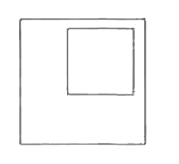Cut out a square of side 7 centimetres and another side 3 centimetres. Cut the larger square súitably and join' with the smaller śquare to make one large square. What is the area of this square?
Ans: Area of the large square =80 square.centimetres Area of the cutout square =8^2=64 Area of the small square =80^circ-64=16 sq.cm One side the the small square =4 ~cm
Similar Questions
What will be the area of square of side 7 cm ?
View SolutionIn the Figure, a square dart board is shown. The length of a side of the larger square is 1.5 times the length of a side of the smaller square. If a dart is thrown and lands on the larger square. What is the probability that it will land in the interior of the smaller square?
View Solution
Knowledge Check
- Question 1 - Select One
If the side of a square is doubled, then the area of the square
Aremains sameBbecomes doubleCbecomes tripleDbecomes 4 times - Question 2 - Select One
The side of a square is 4 cm. It is cut into 4 equal squares. What is the area of each small square?
A4cm2B1cm2C16cm2D8cm2 - Question 3 - Select One
A square contains four times the area of another square. If one side of the larger square be 4 cm greater than that of smaller square, then the perimeter of smaller square will be equal to
A8 cmB16 cmC24 cmD32 cm
In the Figure, a square dart board is shown. The length of a side of the larger square is 1.5 times the length of a side of the smaller square. If a dart is thrown and lands on the larger square. What is the probability that it will land in the interior of the smaller square?
View SolutionThere are as many square centimetres in the surface area of a sphere as there are cubic centimetres in its volume. What is the radius of the sphere ?
View SolutionIn the figure, the smaller square has sides of length 2 and the larger square has sides of length 4. If a point is chosen at random from the larger square, what is the probability that it will be from the small square?
 View Solution
View SolutionIf twice the area of a smaller square is subtracted from the area of a larger square, the result is 14cm2. However, if twice the area of the larger square is added to three times the area of the smaller square, the result is 203 cm2 . Determine the sides of the square.
View SolutionIf twice the area of a smaller square is subtracted from the area of a larger square, the result is 14cm2. However, if twice the area of the larger square is added to three times the area of the smaller square, the result is 203 cm2 . Determine the sides of the square.
View Solution

